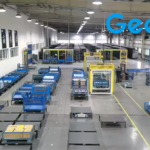ASIA ELECTRONICS INDUSTRYYOUR WINDOW TO SMART MANUFACTURING
TE's Tech Tools to Touts Better and Innovative Robots
The rapid expansion of the application of artificial intelligence (AI) and machine learning has accelerated vigorous development of the robot market. With its extensive engineering proficiency, TE Connectivity (TE) has built a strategic portfolio for the field of service robots to meet customers’ diverse demands.
With the acquisition of Laird Connectivity’s external antenna business and Linx Technologies, TE further refines a high-performance product portfolio of antenna, connectors, etc. Moreover, it strengthens technological advantages and innovation capabilities to support automation across sectors.
Thus, TE values its commitment to the continuous development of the service robot field and creating greater collaborative value for customers.

Widespread Adoption
Since the advent of industrial production, demands for higher and more precise productivity have continually grown. Furthermore, robotics answers many of these demands with the rapid development of technologies internationally.
Of late, there have been robotics breakthroughs in the United States and super manufacturing plants in China. In addition, there is a widespread adoption in Japan. Thus, the global robotics industry is advancing on both the supply and demand sides.
Robotics can help increase production, sales, and quality by offering viable solutions to provide a more effective division of labor and pressures for cost reductions. The potential applications of the robotics industry continue to increase, creating vast market opportunities.
The global robotics market size reached USD 46 billion in 2023, and the International Federation of Robotics expects the market to reach USD 66 billion for the full year 2024. In the market, commercial service robots are becoming increasingly popular across a wide range of use cases to address the challenges of labor shortages and rising minimum wages. Currently, there are six main application areas for commercial service robots:
- Professional cleaning
- Logistics and transport
- Hospitality
- Agriculture
- Healthcare
- Inspection and maintenance
Advent of Service Robots
Compared to industrial robots, there is more emphasis on the interaction experience with service robots. Frequent interactions between users and robots require efficient feedback speeds, placing higher demands on the stability of the wireless connection, high-speed transmission, shock resistance of antennas and other components, and miniaturization technology.
As a global industrial technology company, TE Connectivity plays a crucial role in the service robot field. Specifically, TE’s antennas – using wireless connectivity solutions help enable service robots to perform efficiently in various environments, meeting automation needs across fields and building an innovative ecosystem for intelligent robots.
Meanwhile, TE’s industry-leading antenna and connector technologies provide a broad portfolio of products that support wireless data delivery. These technologies have the needed high stability and high-speed transmission capabilities. Thus, addressing the stringent wireless connectivity requirements of service robots.
Antennas and connectors are undoubtedly two key technologies in the service robot ecosystem. Based on the varying operating environments of service robots, it is critical to select the appropriate antennas. For example, TE’s wireless connection technologies provide stable data transmission and moderate power consumption. Specifically, these technologies include Wi-Fi, Bluetooth, NFC, and RFID for high-security, short-range indoor communication environments.
For both indoor and outdoor operations, solutions such as TE’s antennas for LoRaWAN applications suitable for long-range communication with low power consumption. For longer-range, highly mobile outdoor operations, TE provides products such as ultra-wideband (UWB) and cellular antennas, to support long-distance communication and precise positioning navigation systems.
Wide Range of Solutions
In addition to wireless connectivity, service robots need connectors that account for a wide range of factors. The choice of connectors should be made during the design phase with consideration given to the environment, adaptability, durability, reliability, ease of installation and maintenance. Moreover, they may also need to be waterproof and dust-proof with electrical performance and future scalability.
TE’s broad connector portfolio offers solutions to address these concerns. For example, warehouse transport robots require GPS positioning, which in turn requires data transmission and environment deployment. TE products, such as RF coax connectors, D-Subminiature connectors, or FPC connectors are viable options for consistent and efficient operation. Specifically, they can withstand vibration, high temperatures and other environmental variables.
TE also provides diverse solutions to meet different needs, which can accelerate the speed to market of their products. As a leading company in embedded antenna solutions, TE can support adapting to the mechanical constraints of clients and helping select the appropriate connectors, cables, and frequencies according to requirements. TE antenna solutions using Laser Direct Structuring (LDS) technology can be adapted around existing components or structures to save equipment space.
30 August 2024




